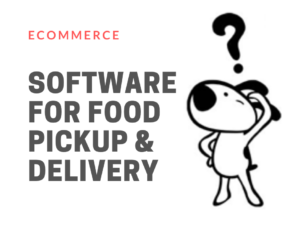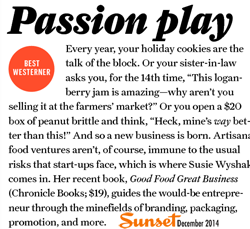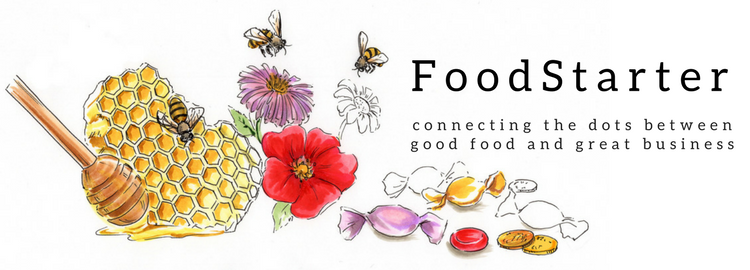This is Part 2 of a 4-Part Series: Re-imagining Good Food Business
(Here are Parts 1, Part 3 and Part 4. Written in 2020, some of the information may be out of date so check for the latest knowledge before making real-life business decisions.)
From webinars, articles, interviews, and stories come a series of imperatives that will help food business startups prepare for success.
Imperative 1: Take time to reflect
“It’s going to be America 2.0. Those companies that adapt are going to do really, really well. Those companies that are set in their ways are going to struggle. When we come out of this reset there are going to be some small companies that blossom because they had a different vision to do things better; Maybe employees have a better way to do things.” -Mark Cuban, INC Webinar, April, 22 2020
What Exactly Happened in March, 2020?
The challenge of delivering enough food was just part of the story. Many grocers had already established “just in time” ordering to avoid keeping lots of back-stock on hand. (This was an issue at Whole Foods well before hoarding began.) The coronavirus pandemic scrambled the U.S. food system, crushing the restaurant industry while pushing up grocery sales at record rates.
A Wall Street Journal article projected that the industry might see permanent changes to the way food is processed and transported, along with fewer choices, higher prices and an adjustment in the way we shop and stock our pantries.”
The Quest For Comfort In Uncertain Times
In recent years, snacking had replaced full meals for many of us. Would things change once we were trapped inside? Indeed, energy and meal-replacement bars for breakfast cooled down. Dips, chips, and treats supplemented meals and our waistlines.
The moment shelter-in-place orders hit, it seemed carb-loving locusts had decimated the pasta and rice shelves in every store, from brick-and-mortar to online.
Bloomberg reported huge sales increases in popcorn, pretzels, and potato chips (all foods that pair well with Netflix). Boxed and canned soups, beans, rice, eggs, and almond milk vanished. All gone.
Early in the pandemic, sales of oat milk far outpaced every other food. Oat milk had already been trending. Even this die-hard dairy lover scooped up a bottle of barista-approved oat milk, swayed by its far-out expiration date.
Steven Spinner, former CEO of food distributor UNFI, reported in March, 2020 that they simply could not get enough soup on shelves. Ramen is emblematic of cheap food in hard times. But UNFI’s major ramen suppliers reported there was no more ramen left in the supply chain. “These shelf-stable, easy-to-make meal-prep items are shining stars right now, including categories that were real pariahs.” Even the experts at UNFI could not foresee this instant change.
The international food conglomerate Mondelez enjoyed huge gains in sales of Oreos and crackers like Triscuits and Wheat Thins. Die-hard, organic-eating friends admitted that when they want comfort, they go for that childhood brand—artificial ingredients and calorie count be damned. In other words, shelf-stability, comfort, and safe packaging became a key requirement for the majority of shoppers. (Meanwhile in Italy, sales of Parmigiano Reggiano were up 36 percent over the previous year. We all have our comfort food.)
Wine tastings also helped comfort people. Those events shifted to Zoom, helped by massive purchases at grocers, wine shops, and e-wine shops. Online sales of beer, wine and spirits saw 243 percent growth compared to the same week in 2019—with economy-sized containers leading the trend.
What, I Have To Cook My Own Meals???
Cookbooks had been a top-selling category for years. The Internet has way too many recipes and cooking shows. Yet, suddenly no one knew how to cook. Meal kit companies saw sales rise. Restaurants discovered the benefit of bundling their foods into containers to make meal solutions.
By May 29, 2020, the Wall Street Journal was questioning which food buying patterns might last, namely the rise in processed and shelf-stable foods from brands like Kraft Heinz and Campbell Soup.
Long shelf-life food sales increased in lock step with frozen foods. It’s only natural we’d want ready-to-eat meals should we become sick. Comforting, healthful boxed soups, jerky, frozen meals, tinned fish, cheeses, marinara sauce, almond milk, frozen veggies and fruit, along with beans and sausage, became my “fallback” foods.
The Produce Marketing Association declared potatoes the fresh vegetable leader once shelter-in-place took effect—perhaps DIY french fries, home fries, and comforting mashed potatoes? In mid-March 2020, canned vegetables and fruit had the most explosive growth over the previous year.
The enterprising took to preserving food and planting “Victory Gardens”. The Coronavirus transformed us—into sourdough bakers. Empty flour shelves became a typical supermarket scenario. Insta-classes on natural starter-making resolved the unusual lack of yeast in stores. Neighbors posted panicked pleas for flour leads on Nextdoor. (My starter rotted, and I tossed it.)
Visions of empty shelves fueled panic. Blame the 80/20 rule: It seemed 80 percent of the population was rushing to 20 percent of the stores, stripping the shelves of Costco and Target, then freaking out. Meanwhile, at least in my area, plenty of small, independent grocers had a variety of good food products, dairy, and great produce in stock—with minimal lines. The farmers markets implemented distancing and cleanliness protocols and made it possible to buy the local foods we love.
As people loaded their pantries, freezers, and refrigerators on infrequent grocery trips in March. Buying slowed in April and beyond as we confronted our overflowing larders and felt sighs of relief as life (and grocery sales) began to normalize.
What We Need
You can usually distill why we do what we do with a simple framework: Maslow’s Hierarchy of Needs. When we’re super crabby from hunger and need to go to the bathroom or are dead tired, our basic human needs are not being met.
You know how good you feel after you eat and the “hanger” is gone, you’ve found a bathroom, and taken a nap? Now you can actually get things done, maybe do yoga or go for a walk with a friend. You’re moving up the hierarchy, meeting your more elevated needs.
Psychologist Abraham Maslow’s diagram perfectly distills our March madness. Most of us were not crazy to load up our larders. We simply panicked at the unknown.
Those of us who were sheltering alone whined about wanting to hug someone and how video chats just weren’t the same…and how we would take any chance to talk to a neighbor or a passerby. We were attempting to fulfill other basic human needs.
Meeting the needs of multiple customers is basic future-proofing. Should the virus return and we are once again forced to reduce our outings to essential shopping trips, those who can meet 80 percent of consumers’ needs will win. (Somehow the idea of an edible toilet paper came to mind as an all-purpose emergency supply. Crazy?)
Readers of Good Food, Great Business know about my coffee obsession. Years ago, I diagrammed the Hierarchy of Coffee Needs to explain how different brands, products, and customer experiences fulfill different needs.
Well, along with shelter-in-place came a “Dalgona“ craze. People who had never touched instant coffee suddenly had to make this creamy coffee concoction. The Dalgona drink originated in South Korea and developed a worldwide obsession in 2020 thanks to Instagram and Tik Tok.
Some saw Dalgonas as substituting for Frappucinos or other cafe creations, which were unattainable for a time. The challenge of whipping an instant coffee, sugar, and water mixture fell right in line with other DIY home cooking experiments. Low risk, high reward. Most importantly, the experiments connected people over social media. (See Maslow’s Hierarchy!)
So we conclude that instant coffee was a hands-down pandemic winner, after several years of sales declines, while ready-to-drink (RTD) coffee sales were on the rise.
Instant coffee had already found a home in my disaster-preparedness kit. The shortages in stores had eerie parallels to a natural disaster aftermath. How come so many of us were unprepared? What can you do to help people prepare?
Imperative 2: Connect Against All Odds
The same business success principles apply in good times and in bad: serve and connect with customers and partners.
March traditionally unites tens of thousands of natural foods exhibitors, buyers, “influencers,” gurus, and consultants at the New Hope Expo West Natural Products Expo in Anaheim, California. Exhibitors at this annual conference represent what you find at a health food store or Whole Foods, including food, beverages, health and beauty products, supplements, and even machinery manufacturers. In March 2020, the event was cancelled last minute—to the dismay of many—just as the severity of the Coronavirus crisis in the U.S. became apparent.
By April, the Specialty Food Association (SFA) cancelled the upcoming Summer Fancy Food Show, for the first time ever. The SFA set up a series of webinars to help members through the barrage of challenges taxing businesses—how to pivot, how to keep sales going, how to get loans or grants, and more.
By May, the Good Food Foundation organized a series of Zoom-based pitch sessions between food crafters and wholesale buyers in which buyers could request samples. The foundation had already gained steam with ten years of Good Food Awards under its belt, as well as Mercantile fairs, as an essential place for smaller food companies to meet wholesale buyers. Virtual meetings plus samples mailed out equals a very similar experience to meeting in person—at a much lower cost in money, time, and effort for all.
In June, New Hope cancelled the 2020 Expo East trade show and announced an online “trade show” called Spark Change. KeHE Distributors also announced an online Holiday Show for retailers to discover innovative trends and suppliers, then place orders.
Despite the distance, it’s remarkably easy to connect with industry experts and peers.
The Hirshberg Institute held a truly incredible two-day online food business bootcamp, complete with pitches to investors and insights from natural foods industry veterans. (One of the entrepreneurs, Slice of Sauce, got started by reading my book!) The online format allowed people from across the globe to attend—for a mere $50. One key takeaway is that women-owned businesses should certify as “women owned” before approaching retailers. You’ll save money and have an edge in selling. The event videos are now online.
A trade community of groups called “Naturally” has sprung up in several cities around the country. The groups offer events, resources and connections for new and established natural food companies. On one webinar, the CEOs of Miyoko’s Creamery, Amy’s Kitchen, and Traditional Medicinals Tea shared their experiences of the pandemic.
Then there’s the international Slow Food organization, protector of heritage foods, flavor and preparation techniques. Throughout the pandemic, Slow Food chapters worldwide tapped into online networks and social media to unite the real, physical network of producers, cooks, and activists. They reduced the sense of distance and isolation and created space for new initiatives of solidarity.
You’ll find many examples of food ecosystems and collaborations across the Slow Food network. These examples serve as inspiration to design a future of sustainable, regenerative food systems–how we produce, distribute, buy, and eat.
Just six months before COVID-19 reached pandemic levels, the streets of Bra, Italy, home to Slow Food, teemed with small producers of cheese, charcuterie, and sweets from around the world. This event was one of the best things I’ve ever checked off my “bucket list.” I tell you this if only as a reminder to carpe diem!
Imperative 3: Be Vulnerable
We’re all on the same playing field because we’re all experiencing the same pandemic.
-MIYOKO SCHINNER, CEO AND FOUNDER, MIYOKO’S CREAMERY
You already read about the CEO of major food distributor UNFI admitting that the supply of soup was an unknown. That is vulnerability.
Brené Brown wrote the book on the power of vulnerability (and gave the popular TED Talk on that topic). Admitting we don’t have the answers, and that we need help, is key to success at this time. Actually, all the time. Listen to Brené laugh at her foibles in her Texas twang if you don’t believe me.
In 2020, the most unlikely businesses have gone bankrupt. No one knows what’s going to happen. Fear of criticism almost stopped me from writing this book; it would surely be out of date just moments after publication.
Then came these words from another Texan, Mark Cuban: “The marching orders I’ve given [my companies] are to communicate with any and all stakeholders. Be honest; you can’t bluff anyone. By being honest and authentic, people will know you’re in this with them. Be as transparent as you possibly can be. It’s ok to say there’s uncertainty. When we open up, your customers and prospects will appreciate you more.”
Keep authenticity in mind as you connect with customers, employees, suppliers, buyers, and the media. That means not embellishing your story, or where or how you produce your food, or trying to be perfect. It means admitting you don’t know the answers or are scared. (Those of us who have worked in “Corporate America” know how hard showing your true colors can be!) Blair Kellison of Traditional Medicinals Tea even sees Zooming from home as an opportunity. Leaders can connect with colleagues from a level playing field: the kitchen table.
Maureen Foley’s Red Hen Cannery is vulnerability personified. Her story reminds us that the pandemic is just one of many recent natural disasters. Maureen had started as a home-based preserves business in the Santa Barbara, California area. She won a Good Food Award, eventually growing into a licensed commercial kitchen with five employees and 30 wholesale outlets. Fires. Floods. She retrenched back to her home-based business, selling at local farmers markets. Talk about a humbling experience.
Keep It Real On Social Media
Start your marketing by developing a fan base. Connect with them through social media and email—assets that will keep on giving as you “own” the relationship. Make really great food, and you will never have to pay professional influencers to promote it.
For example, Nancy Silverton asked her Instagram followers to tag two friends and make a case, in 10 words or less, as to why we deserved a shipment of Nancy’s Fancy Gelato. The prospect of pigging out garnered more than 5,000 likes and 500 comments. That’s a lot of genuine fan engagement for a very small investment.
Gary Hirshberg talks about the power of inviting bloggers to the farms behind Stonyfield Farms. The passion they bring to their writing and social media as a result of seeing production firsthand is invaluable. Obviously, this works more for farm-based products with adorable animals. (See Big Picture Farm’s Instagram feed if you don’t believe me.) You’re not going to bring bloggers to your co-packer’s factory. Or maybe you will. I did take an incredible tour of Germany candy factories!
Absent baby lambs, conversations with the founder, along with shipping samples lead to strong engagement. People talk about the importance of story, especially to millennials. But think about the foods you really rave about. Do you rave when there is no story behind the food? I know I do. So do thousands of people in Trader Joe’s Facebook fan groups.
Remember the Dalgona frenzy as you craft your marketing plans. Involving fans, genuine interaction, and entertainment may be your secret sauce. Just today, I stared at a chef cradling a hedgehog for 30 seconds of my life.
Setting expectations with customers is key.
Imperative 4: Design For Flexibility
Just like every relationship, a personal connection, customer focus, and ability to change will help you weather the most challenging business situations.

Did it really take a pandemic to remind us of that old adage “Don’t put all your eggs in one basket”? The food industry took a crash course on the benefits of multiple customer bases and distribution systems.
I haven’t heard of anyone doing a what-if exercise on: “What if all high-end restaurants were to close?” Yet, in a flash, fine dining declined almost 90 percent.
Farms dependent on the foodservice channel—restaurants, hotels, event venues—suffered. Others who managed to shift from selling from foodservice to consumers thrived (or at least weren’t hurt as badly).
What if demand for your foods tanked in one day?
All businesses should plan what-if scenarios going forward. When doing so, consider the myriad ways you might re-deploy and re-imagine your operations For example:
Taking stock of its assets—refrigerated processing centers, distribution centers, and a fleet of refrigerated trucks— helped Curation Foods serve the increased demand for salads and packaged, fresh-cut vegetables sold to retail and club channels. The company reduced production of products designed for large events: guacamole in large tubs and vegetable trays.
Pivoting stories help us imagine the possibilities and build in flexibility for an uncertain future:
Shifting Stories: From Retail to Delivery
Seven Sisters Kitchens is a popular dine-in café in Georgia. Upon shelter-in-place, owner Farrah Haidar shifted her focus to an online shipping operation—Seven Sisters Scones.” Goldbelly became an essential third-party marketer of the bakery’s products. “It kept us in business, and we think it is one of the most viable ways forward,” Farrah says. We have a 16-seat shop. It’s almost impossible to effectively social distance. We won’t put our employees or customers at risk in that way.” Delivery gives Seven Sisters the flexibility to keep the business running safely.
Local home delivery services have popped up around the country as well. Cow Belle in rural Pennsylvania, Shatto Home Milk Delivery in Missouri and Good Eggs in California are just a few examples. These local distributors are especially handy if you’re selling perishable or frozen products and meals.
Shifting Stories: Selling Groceries at Restaurants
The words flexibility and government don’t usually go together. But in March, the Federal Drug Administration (FDA) wrote what they called a temporary law allowing restaurants to sell ingredients and prepared foods as products, with minimal informative labeling such as ingredients and allergens. They also temporarily waived Country of Origin Labeling (COOL) requirements to allow the re-distribution of food products intended for foodservice to be sold in retail establishments. COOL is a labeling law that requires retailers to notify their customers with information regarding where certain foods originated.
The idea of the labeling law was to allow food to be diverted from shuttered restaurants to retail stores and families. Around the country, independent restaurants and even chains took advantage of these rules to serve their communities. For example, Frisch’s Big Boy restaurants in the Midwest took items already at their commissary and added them to the drive-thru and carryout menu. “Big Boy’s Market” offered items such as half gallons of milk and chocolate milk, five-pound bags of sugar, produce normally used on their menus, and single rolls of bathroom tissue (limit four per order!).
Similarly, Panera began selling toilet paper, bread, and other groceries. Sales have been so brisk that the company plans to add food categories and meal kits to “Panera Grocery” soon and continue the business line after the crisis.
Supermarket Guru Phil Lempert is a long-time proponent and tracker of the “groceraunts” concept—restaurants inside grocery stores. Who knew the reverse would happen one day on a large scale: grocery stores inside restaurants. In reality, what he calls a “restaurmart” is not entirely new. Chains like Cracker Barrel and Anderson’s Pea Soup have stores that accompany the restaurants where they sell their own foods as well as other brands. Lempert predicts that “restaurmarts” might save the foodservice industry.
Shifting Stories: Drive-Through Grocery Pickup
Between March 13 and March 17, Choicelunch went from serving lunches to 25,000 students at 300 California schools to 0 students at 0 schools. Suddenly, 200 employees had no work. The company had to scramble to survive.
Then came the Great Grocery Panic of 2020. They connected the dots to leverage food distributor relationships, food warehouses, and 50 refrigerated trucks into a drive-through grocery service. The idea was to sell high-demand foods and goods that people couldn’t easily order online or find in stores (of which flour and eggs turned out to be key). “Choicelunch Pantry” added limited prepared meals, thanks to the company’s experience in food service and their commissary kitchens. Then a local bakery and enterprising hand sanitizer maker came on board. With some media exposure and social media, cars happily lined up.
The family behind the Milk Pail Market in Mountain View, CA—which had shut down a year earlier—marshalled its connections, knowledge, and base of passionate ex-customers to design a thriving drive-through contactless specialty food pickup service. The service continued even after we could easily shop in-store again.
The Key to Flexibility: Direct-to-Consumer Selling
Many food startups have “get into Whole Foods!” as their first goal. Yet selling directly to consumers (D2C) has always had its benefits. Whether online, at farmers’ markets, pop-ups, or local food boxes and delivery services, you can experiment and try out various packaging and bundling ideas. Most of all, you avoid the risk of your unknown product languishing on a shelf. Once you’ve got your followers and know what customers want, then look at selling in retail.
In their work researching trends and culture, Hartman Group found that in early 2020, 14.5 percent of grocery spending was online—a huge leap over 2019. Online sales zoomed up to 27.9 percent of all grocery spending during March and April, with 12 percent saying it was their first time purchasing fresh produce online.
Wherever this trend goes, being ready to serve consumers however they want to purchase is key. Even Mondelez got in the consumer-direct game. They created boxes stuffed with dozens of their sweet and savory snack products to sell on Amazon.
Tip: Consider including samples and coupons in any packages you ship!
Amazon, Thrive, Oh My
This may be the perfect time for brands to launch as “digital natives”—purely online or at least online first. Blk & Bold Coffee made a killing on Amazon during the pandemic. The Black-owned coffee roasters found success in the intersection of great product, availability when we were all making coffee at home, and a heartfelt mission.
More than 50 percent of consumers turn to Amazon to search for products. That’s right, not Google, not HomeDepot.com, not Apple.com. At the Hirshberg Institute bootcamp, Veteran Whole Foods leader Walter Robb pointed to brands such as Smarty Pants Vitamins building a following online first before heading into retail stores. Puracy cleaning products and plant-based protein company Kos are other examples.
Amazon offers flexible options—either you fulfill or they do with Fulfillment By Amazon (FBA), where Amazon stocks and delivers your goods. Betsy McGinn combines expertise in the food space and Amazon. Her Amazon Roadmap can point you in the right direction.
In addition to Amazon, take a look at the organic-centric Thrive Market—which gained 100,000 delivery subscribers during the pandemic. Thrive plans to increase its selection over time to keep its members happily renewing their subscriptions.
Goldbelly is another kind of marketplace. It offers consumers everything from meal kits to subscriptions from restaurants and food makers around the country. You already read about how Seven Sisters Scones depends on Goldbelly for delivery. They’re one of few marketplaces I’ve seen that co-mingles old-time packaged candy with artisan halva and fine dining with fast-casual food subscriptions—a strategy which is sure to broaden their customer base.
Want to sell on Walmart.com? Stay tuned for what may have been the best online selling news in 2020.
Build Your Online Store
Several excellent e-commerce systems give sellers the flexibility to quickly change policies and purchase options as well as to let customers choose from an array of payment and delivery options. (Here’s another blog post on deciding which system is for you.)
 Research your options and ask companies you respect how they go about their operations. Always be sure to add up costs from vendor services and understand the payment cycle to make sure it works for you!
Research your options and ask companies you respect how they go about their operations. Always be sure to add up costs from vendor services and understand the payment cycle to make sure it works for you!
Wow—Shopify + Walmart.com
Shopify is a very popular online selling platform with many of the same features as other online store systems. The big difference is that Shopify depends on “plugins” developed by third-party developers for custom functionality and integrations. These plugins often have a monthly cost but can give you a big-brand customer experience.
The most important thing to know if you are selling online: In June 2020, Shopify announced a deal with Walmart, called Walmart Marketplace. It’s a big deal. Shopify customers can apply to sell on Walmart.com and start doing so easily, if accepted. A seamless connection between your Shopify store and Walmart.com places your products in the Walmart Marketplace. If you want to get discovered by Walmart.com shoppers, this alone makes Shopify worth a look.
If you’re planning to move millions in merchandise or want control over logistics, you’ll want to see what warehousing and delivery options are out there. For example, FlowSpace claims they are “the fastest and easiest way to store, manage and fulfill your inventory from over 1000 warehouses and fulfillment centers.” DeliveryBizPro says they power delivery of more than 600,000 products locally every month. (DeliveryBizPro powers Shatto Home Milk Delivery, which I mentioned previously.)
Other Popular Online Store Solutions
Maine’s Fork Food Lab incubator illustrates the simple beauty of SquareSpace. Also using SquareSpace, Mortal Kombucha was able to pivot from selling to corporate offices, cafes, breweries, and retailers to a home delivery model.
Not to be confused with SquareSpace, Square has expanded not only to handle point-of-sale and mobile payments at events but payroll, gift cards, and more, all wrapped within free ecommerce software. Starter Bakery in Berkeley, CA had been selling wholesale, for catered events, and at farmers markets. Their Square system allowed for taking orders for pickup and delivery during shelter-in-place. Starter also was able to take orders intended to be donated to frontline hospital workers—a hugely popular option that was a win for all.
Whatever technology you choose, consider all the possible scenarios in which you might need to sell. The pandemic makes the perfect playbook:
- Taking credit cards in person by tap or swipe (contactless is critical).
- Taking credit cards online.
- Eating in-store, pickup, delivery with third-party services.
- Ideally, your system can also accept EBT (electronic food stamps).
Farms also can benefit from flexible technology. Dr. Gail Feenstra, deputy director, Sustainable Agriculture Research and Education Program, University of California Davis notes that “small and mid-scale growers are more adept at changing their business and distribution models to meet the needs of their communities, and some farmers have found new outlets: selling partly to school districts, doing CSAs (Community Supported Agriculture) or direct deliveries, and working with food banks.”
Tomatero Farm in California was just one grower depending on produce sales to restaurants and grocery stores, along with farmers’ markets. When restaurants drastically cut their purchases, they put together a “farm box” program either for contactless pickup at farmers’ markets, or other pickup points. Luckily, the technology and networks now exist to help small farms get their food into your hands.
Tomatero got the message across that this was a no frills, non-customized, no substitution box. Customer happiness is all in setting expectations. Fans shared their offering far and wide.
Selling in Retail
Good Food, Great Business goes in depth into selling in grocery and other stores. Of course, things have changed. Remember tasting a cheese with jam at the grocery store? That experience is gone…maybe forever. Sampling is the best way to sell. Darn that COVID-19!
In the future, handing out coupons and maybe packaged samples could be the new face of tasting in-store. Ample social media videos, product giveaways, online coupons, and testimonials are more important than ever.
Here are a few more ideas and updates about ways to sell sustainable, good foods at retail:
Selling to Whole Foods and Other Chains
We all know Whole Foods. Nearly $18 billion in sales in 2019. They may be owned by Amazon, but Whole Foods customers still seek out unique, delicious foods with a genuine, mission-driven story. What Whole Foods wants from its brands dovetails with what millennial customers want. Branding expert Alex Bogusky distills this as taste, then convenience, then mission.
Being differentiated from the competition, open to feedback and partnership, and being able to tell your brand or product story in active, involved ways will increase your chance of getting into Whole Foods and staying on the shelf.
At the basic level, every vendor must meet the Whole Foods Quality Standards. If you do, take a look at the company’s information for vendors and register on Range.me. Your profile and products will reach numerous wholesale buyers who source through RangeMe, from 7-Eleven to Wegman’s to vending machine companies and discounters.
Peruse the buyer list when planning your product and packaging strategies. Doing so may spark a new idea! Good Food Great Business has lots of tips about how to position your foods for success.
Selling to Independents
What’s better than selling to your favorite indi natural foods store? Reaching many at once! The Independent Natural Food Retailers Association (INFRA) has more than 250 members across 46 states. As of May 2020, the association has 255 members in 46 states. INFRA is a purchasing cooperative grounded in mission and vision. It started as a concept for independents to collaborate on forging a sustainable future and now represents $1.8 billion in combined sales.
Most of the member-retailers commit to supporting a resilient food system. They look for brands that have purpose and are “mission forward.” Yet the stores cannot be publicly traded or more than 50 percent owned by venture capital.
If you would like to pitch INFRA as a new vendor, you can email newvendors@infretailers.com
Selling to Co-op Grocers
Co-op stores are a different animal from the independent natural grocery stores. They are co-operatively worker owned and / or customer-owned via membership. Co-op markets also have their association, called National Co-op Grocers (NCG). The NCG says that its members look for the intersection of value and values when considering brands. The NCG can help brands get on more co-op shelves quickly.
Local buyers still have a lot of autonomy. They’re interested in unique, innovative, well-differentiated products—and especially the stories behind the product. To me, the hallmark of a “good food” is that it has been accepted and is popular at a co-op grocery store!
NCG members primarily order through UNFI; co-ops use a number of regional distributors as secondary suppliers. Brands can present new items to NCG, which works with co-ops across the U.S. to get those on the shelves at many co-ops all at once. Co-ops have visibility to see which items are selling at their sister co-ops.
Learn more and contact NCG online if you’re interested in selling at co-ops.
Imperative 5: KISS (Keep It Simple, Seriously)
“We had our best month ever when it came to production and capacity.” said Xavier Unkovic, Amy’s Kitchen President
Amy’s Kitchen was producing 228 food products. The pandemic forced a staff cut. Yet consumer demand was soaring, as we all filled our fridges and freezers.
On a Naturally Bay Area webinar, Xavier Unkovic, Global President at Amy’s, explained that how you respond isn’t about being perfect. “It’s how fast you can respond and how you act that is going to make a difference.” The team wanted to address the surge in demand. How could they produce more products, more quickly?
The answer was to simplify. Amy’s reduced its offerings to 71 products. By doing so, they could efficiently increase production of popular products such as frozen mac and cheese, pizza, and enchiladas. “We have been rewarded by doing this, as we were able to serve more consumers,” Unkovic reflected.
This success would not come as a surprise to “the world’s expert on choice,” Professor Sheena Iyengar. She reported, on a Hidden Brain podcast, that the pandemic’s limiting choice for people at the grocery store might make them happier. (You may know Iyengar’s name from the famous Jam Study, a surprising experiment in choice that every food entrepreneur should know about.) Indeed, fewer choices has been credited as one of Trader Joe’s secrets to success.
Amy’s was not alone in pursuing a less-is-more strategy. Numerous consumer packaged goods (CPG) companies from Mondelez to Procter & Gamble and Hain Celestial quickly began producing more of their most popular products during the pandemic, rather than those fun and interesting brand extensions. Bolthouse Farms cut down its baby carrots offerings to four from more than a dozen, and PepsiCo plans to ax less popular products along with foods that are difficult to produce.
It’s the 80/20 rule in action! Produce the 20 percent of products that 80 percent of consumers will want. Narrowing the range of products you produce helps you streamline production and conserve your cash. Seasonal, limited, or “beta” flavors are always a great idea for small-batch producers to keep customers engaged.
This echoes the suggestion of John Raiche, executive vice president of supplier services for UNFI, who suggests manufacturers reduce the number of SKUs, or items, they produce. One well-known supplier is reducing its SKUs with UNFI to four from 100!
Think Positively. Act Conservatively.
Keeping things simple means avoiding problems. Avoiding problems takes foresight and cautious optimism, as opposed to irrational exuberance.
The Hirshberg Institute bootcamp kicked off with straight talk: “How Not To Run Out of Cash,” coupled with a walk through of Gary Hirshberg’s very own cash-flow spreadsheet. Some key advice at the Bootcamp from industry veterans includes:
- Delay what you’re forecasting. Specifically, reduce the revenue you think you’ll be making by 50 percent. Ouch.
- Speed up sales to increase your chance of success.
- Capital efficiency is the new velocity. Slow down.
- Be discerning about what activities to invest in. They say: “As squirrels we like to chase the next nut.” Differentiate important from interesting.
- Your job as a founder is to do what’s best to keep the business going. Be passionately dispassionate when looking at SKUs, your team, your contractors. Make good, tough decisions to be good to everyone involved. That might not mean being nice.
The bottom line: discipline wins. Being disciplined around cash flow is critical. It is a top predictor of a business’ ability to survive and thrive.
You can see all the recordings from this invaluable bootcamp and get the spreadsheet on the Hirshberg Institute website.
“Planning is not good enough because chances are if you plan too much things will not go as you planned.” said Jose Andres on NPR’s How I Build This with Guy Raz podcast
NEXT: On to Part 3.







